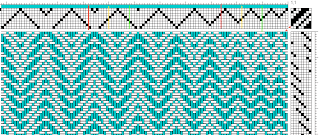16/10/2014
Fanning for the future?
Before I had discussed fan-reed ideas with Pat, it had not even occurred to me to strive for straight edges. I mean - when you can do curvy, when in fact the whole idea is to make curves, why not do curvy edges as well? Oddly enough, Pat said the same, only opposite: fabric, whatever the use, should always have straight edges.
So I cooked up something radically different (from what I had tried previously): an advancing point threading with an advancing treadling - neither threading nor treadling "evening" with the reed:
To accomplish straight edges one has to sley from one "middle-of-the-fan" to another "middle-of-the-fan". With my reed that means the warp has to be offset a bit. As there are 26 dents/fan, and I sley double, I made the colour code on the draft above (click to biggify!):
from the right, from start to first red line, the 26 ends go in the half-fan; next fan gets 52 ends (to second red); from second red to first yellow, from first yellow to second; from second yellow to first green... I simply ended where I had the last half-fan filled.
The treadling repeat is 40 picks, I move the reed every 10 picks, and use 6 positions. This means the reed movements/treadle sequence do not coincide until after 8 complete reed movements.
Finally, I had found something that looks promising on the loom! In my experience, all fanned cloth looks streaky on loom - so did this:
After fringeing, wet-finishing including pressing and mangling, it looks like this:
Most (but not all) weft streaking evened out with wet finishing, and the edges are tolerably straight.
But something funny happened when it was still damp: I was pressing, and dragged it along the ironing board. Look what happened:
My first thought was that I had somehow "ruined" the straight edges, but it was just a passing phenomenon. When it was completely dry, it stopped doing that.
Someone suggested a fabric like this could be a nice yardage, for a jacket maybe.
I like the thought, but have no idea what yarn to choose.
The reed is a nominal 50/10cm, which means the most open part is somewhere 3-3,5 dents per cm, the closest end has about 12 dents per cm. For this piece I used cotton 16/2, and it is a bit too open in the open parts, I'm afraid it will easily snag.
But with a thicker yarn... how would that work in the close parts?
A yarn with more tooth, like linen, would perhaps work better structurally - but my first (ever) sample had linen warp. It got cut off after many, many mended ends and some 30 cm. Maybe it would work with linen weft only?
Or should I try wool? With a carefully monitored fulling?
Subscribe to:
Post Comments (Atom)








2 comments:
Wow, fantastic, exaggerating the fanning. I guess the textural bumps is another feature, although I'd be so thoroughly tempted to steam press it to death.
What fun. :)
cheers,
Laura
Post a Comment